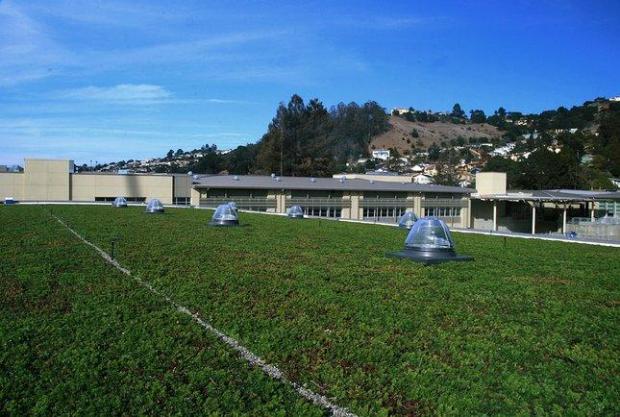Source: eastbaytimes.com
Published: July 5, 2016

CREDIT: LIVEROOF– The roofs on the Korematsu Middle School gymnasium and multipurposebuildings include layers of drought-tolerant sedum plants above awaterproof lining that channels rainwater runoff into storm drains.
By Rick Radin
EL CERRITO — The new Korematsu Middle School at 1725 Donal Drive has a feature that aims to please the neighbors as well as the environmentally conscious city at large in the form of a pair of “living roofs” on two of its buildings.
The roofs that crown the school’s gymnasium and multipurpose rooms consist of layers of drought-tolerant sedum plants above a waterproof lining that channels rainwater runoff into storm drains.
Sedum is a leaf succulent with water-storing leaves that act as filters for the rainwater to eliminate pollution and reduce runoff by 65 percent to 90 percent in the summer and 25 percent to 40 percent in the winter by holding more water for evaporation.
The plants also capture air pollution and provide a friendlier environment for the larger ecosystem, including birds and insects, according to LiveRoof Global, LLC, the company that manufactures the roofs.
The roofs serve as efficient insulators, reducing the cost of heating the buildings during the winter and cutting noise inside the buildings by up to 40 decibels to provide a better instructional environment for teachers and students.
“The buildings aren’t air conditioned, otherwise there would also be electricity savings during (warm weather),” said Luis Freese, the chief engineering officer for the West Contra Costa school district.
The installations also serve as air filters as each of the 15,000 square feet of roof filters seven ounces of dust and smog per year. In addition, photosynthesis also reduces airborne greenhouse gases in the atmosphere, according to LiveRoof Global.
The district came up with the idea for installing the roofs to reduce glare for neighbors on Lawrence Street and other streets east of the campus, Freese said.
Korematsu also has a retaining wall on the east side with a plaza beneath. The site slopes to the west with the taller school buildings further down slope to avoid blocking views as much as possible.
The green roofs added about $217,000 to the cost of conventional roofs, according to SGI Construction Management, the lead contractor on the project.
But since the roofs are expected to last about 40 to 50 years, in the long run it could save $300,000 to $400,000 by avoiding the need to replace worn-out conventional roofs.
“This was originally a mitigation measure to come up with a non-reflective roof to try to cut the glare and soften the view,” he said.
The other buildings on the campus have brown, pitched roofs that also absorb rather than reflect light, Freese said.
The sedum plants were raised at a nursery in Watsonville operated by a LiveRoof Global contractor before they were installed on the roofs.
